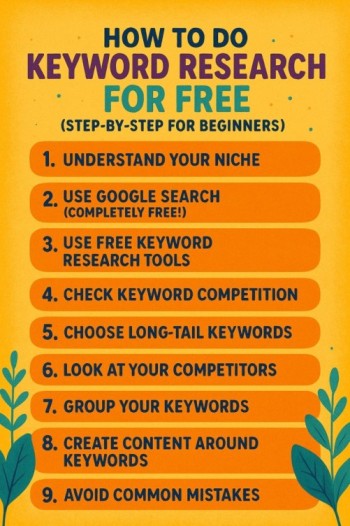New to SEO? Follow these 10 easy steps to do keyword research for free. Start finding keywords that help your site grow and rank.
If you want your blog, YouTube channel, or website to show up on Google, then keyword research is your best friend. Think of it like a treasure hunt. The “keywords” are the map that shows you where people are searching, and your content is the treasure they’re looking for.
Don’t worry if this sounds a little tricky. I’ll break it down step by step in the simplest way possible . And yes, you don’t need to spend a single rupee. Everything here is 100% free.

1 . What is Keyword Research (in Simple Words)?
Imagine you open Google and type “best chocolate cake recipe”. That phrase is a keyword. Keyword research is nothing but finding out what people are typing in Google so you can write about it.
Example:
If 10,000 people are searching for “easy cake recipe” every month, and only a few blogs are writing about it, that’s a golden opportunity for you!
2. Why is Keyword Research Important?
Here’s why you should never skip keyword research:
• It tells you what people want.
• No point in writing about something nobody searches for.
• It helps you get traffic.
• The right keywords bring more people to your site.
• It boosts your earnings.
• More traffic = More AdSense clicks = More money.

Step 1: Understand Your Niche
Before hunting for keywords, ask yourself:
1. What do I want to write about? (e.g., food, fitness, travel, marketing)
2. Who do I want to help? (students, beginners, moms, business owners)
Example: If your niche is fitness, then your audience might search for:
“easy exercises at home”
“how to lose belly fat”
“best diet plan for beginners”
Step 2: Use Google Search (Completely Free!)
Google itself is the best keyword tool.
Here’s how you can use it:
1. Type your topic in Google. Example: “digital marketing for beginners”
2. Look at the suggestions that drop down. These are real searches by people.
3. Scroll down and check “People also ask” and “Related searches”.
Example:
If you type “blogging tips”, you’ll see:
• blogging tips for beginners
• blogging tips to make money
• blogging tips and tricks
These are your free keyword ideas!
Step 3: Use Free Keyword Research Tools
There are many paid tools like Ahrefs and SEMrush, but beginners don’t need those. Here are some free tools you can use:
1. Ubersuggest (Free version)
• Go to Ubersuggest.
• Enter your topic.
• It will show search volume, competition, and keyword ideas.
2. Answer the Public
Enter a keyword like “blogging”.
• It will show questions people are asking like:
• What is blogging?
• How does blogging make money?
• Is blogging worth it in 2025?
3. Keyword Generator (Ahrefs free tool)
• Gives you tons of keyword suggestions instantly.
4. Google Trends
• Helps you see if a keyword is growing or fading away.
• Example: “AI tools” is trending upward, while “CD players” are going down.
Step 4: Check Keyword Competition
Not all keywords are easy to rank for. Some are very competitive.
Here’s how to check:
1. Type the keyword in Google.
2. Look at the first page results.
3. Ask: Are these big websites (Wikipedia, Forbes, etc.) or small blogs?
• If it’s big sites → tough keyword.
• If it’s small blogs → you can rank.
Example:
Keyword: “How to start a fitness blog”
• If first page is filled with personal blogs then there is Good chance for you!
• If it’s only Healthline, VeryWellFit, WebMD then it’s Harder to rank.
Step 5: Choose Long-Tail Keywords
Long-tail keywords are phrases with 3-5 words. They are easier to rank and bring targeted traf
Example:
Short keyword: “blogging” (too broad, very competitive)
Long-tail keyword: “blogging tips for beginners in 2025” (specific and easier to rank)
• Benefits of Long-tail Keywords:
• Less competition
• More specific audience
• Higher chance of ranking fast
Step 6: Look at Your Competitors
One of the smartest ways to find keywords is by checking what others are ranking
Here’s how:
1. Find a blog in your niche (example: fitness, food, or marketing).
2. Copy their website URL.
3. Go to a free tool like Ubersuggest or Ahrefs free site explorer.
4. Paste the URL.
5. You’ll see the keywords they are ranking for.
Example:
If a fitness blogger ranks for “10-minute morning workout”, you can create your own version: “Easy 10-minute morning workout for beginners.”
This way, you don’t reinvent the wheel—you use what already works.
Step 7: Group Your Keywords
Once you have 20–30 keyword ideas, don’t just write random articles. Organize them into grou
Example (if your niche is blogging):
• Blogging Basics → “what is blogging”, “why blogging is important”
• Blogging Tips → “blogging tips for beginners”, “blogging mistakes to avoid”
• Blogging for Money → “how to earn from blogging”, “best AdSense alternatives”
When you group keywords, your blog looks more organized, professional, and it also helps Google understand your site better.
Step 8: Create Content Around Keywords
Now comes the fun part—writing content.
But remember:
Don’t just stuff keywords everywhere.
Use them naturally in your:
• Title
• First paragraph
• Subheadings
• Meta description
• Image alt text
Example:
Instead of writing “Blogging tips blogging tips blogging tips”, write:
“Here are some easy blogging tips for beginners to help you start your journey without getting confused.
This way, it’s reader-friendly and also SEO-friendly.
Step 9: Avoid Common Mistakes
Beginners often make mistakes that stop their blogs from ranking. Here are the top ones to avoid:
1. Choosing keywords with no searches – Don’t waste time writing about things nobody is searching.
2. Targeting very hard keywords – Competing with Wikipedia or Forbes in the beginning is almost impossible.
3. Keyword stuffing – Using the same word again and again looks spammy and hurts your SEO.
4. Ignoring user intent – If someone searches “how to bake a cake”, they want steps, not history lessons about cake.
Step 10: Track Your Results
After publishing your blog posts, you need to check if your keywords are working.
Here’s how you can track for free:
Google Search Console (Free)
• Shows which keywords bring traffic to your site.
• Tells you your average position on Google.
Google Analytics (Free)
• Helps you see how many visitors are coming.
• Shows what blog posts are most popular.
Example:
If your blog “Easy cake recipes for kids” starts showing up on page 2 for the keyword, you know you’re moving in the right direction.
Pro Tips for Beginners
Let me share some extra tips that can make a huge difference:
• Target questions like “how to…”, “what is…”, “why does…”. These are easier to rank.
• Mix short and long-tail keywords for balanced traffic.
• Update your content regularly—Google loves fresh content.
• Add FAQs at the end of your post using keywords.
• Use internal linking (linking one blog post to another) to boost SEO.
Example of a Keyword Research Process
Let’s imagine you’re starting a food blog. Here’s how you could do keyword research:
1. Topic: “Easy breakfast ideas.”
2. Google suggestions show:
• easy breakfast recipes for kids
• healthy breakfast ideas for office
• quick 5-minute breakfast recipes
3. Use Answer the Public → Finds questions like:
What is the healthiest breakfast?
How to make breakfast quickly?
4. Pick a long-tail keyword: “quick 5-minute breakfast recipes for office”.
5. Write an article with that keyword in title, intro, and subheadings.
6. Publish and track it in Google Search Console.
Frequently Asked Questions (FAQs)
Q1: Can I do keyword research without paid tools?
Yes! Google Search, Answer the Public, and Ubersuggest’s free version are enough for beginners.
Q2: How many keywords should I target in one blog post?
Ideally 1 main keyword + 2–3 related keywords.
Q3: How long does it take to rank?
Usually 3–6 months for new blogs, but with low competition keywords, you might see results faster.
Q4: Should I focus on short or long-tail keywords?
As a beginner, focus on long-tail keywords. They’re easier to rank.
Final Words
Keyword research is not rocket science. It’s simply about listening to what people are searching for and giving them the best possible answer.
If you follow these steps:
1. Understand your niche
2. Use Google and free tools
3. Check competition
4. Pick long-tail keywords
5. Create helpful content
… then you’re already ahead of 80% of beginners.
Remember: Google rewards helpful content. So instead of chasing only keywords, focus on solving real problems. Do that, and not only will your blog grow, but your AdSense earnings will grow too!
Pingback: What is SEO? The Ultimate Beginner’s Guide To Search Engine Optimization in 2025 - auraclix
Pingback: Local SEO: How Small Businesses Can Rank in “Near Me” Searches in 2025 - auraclix